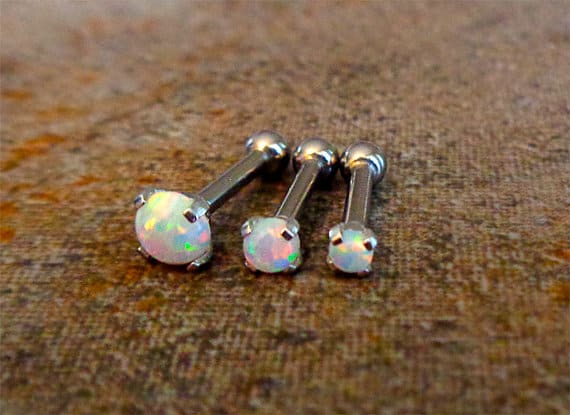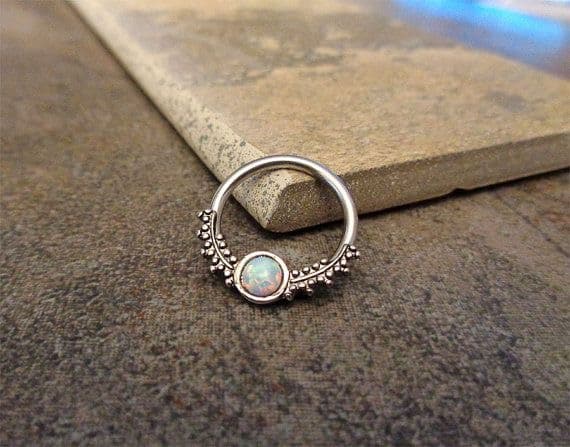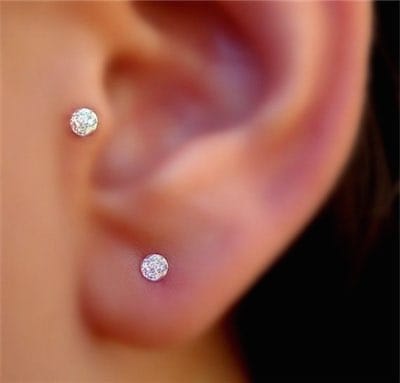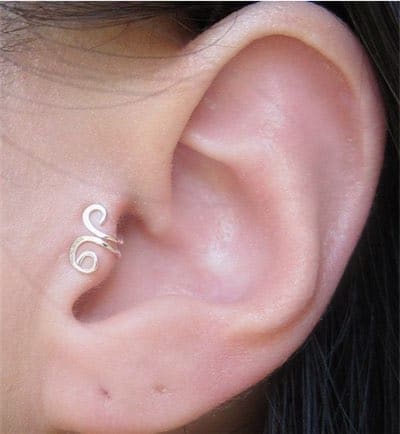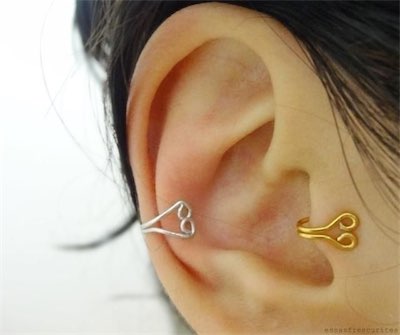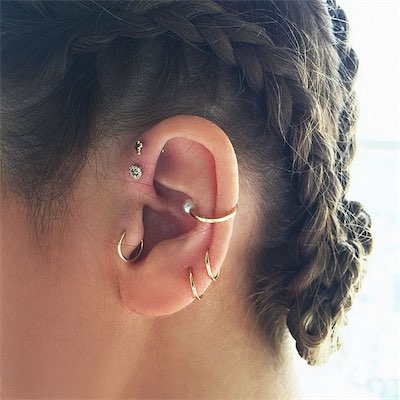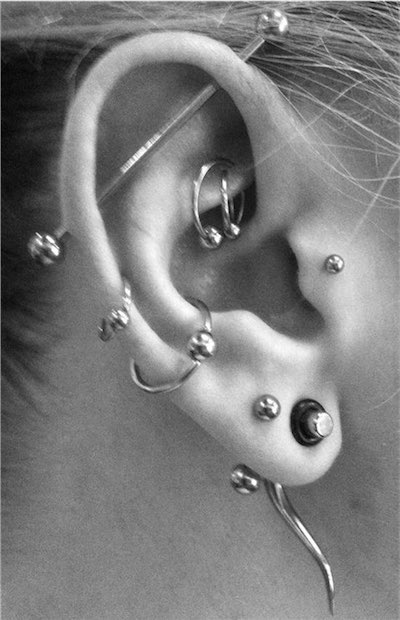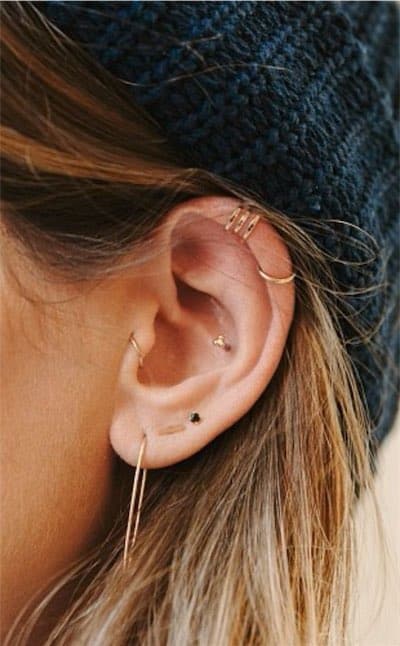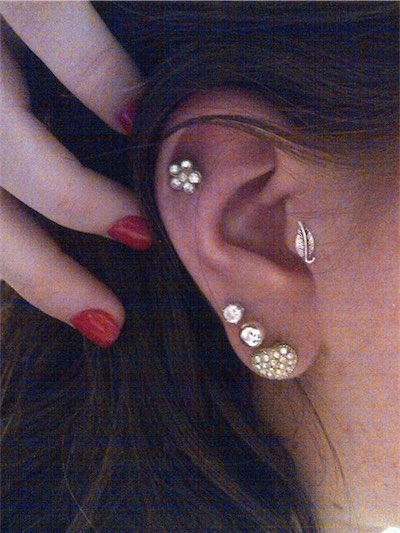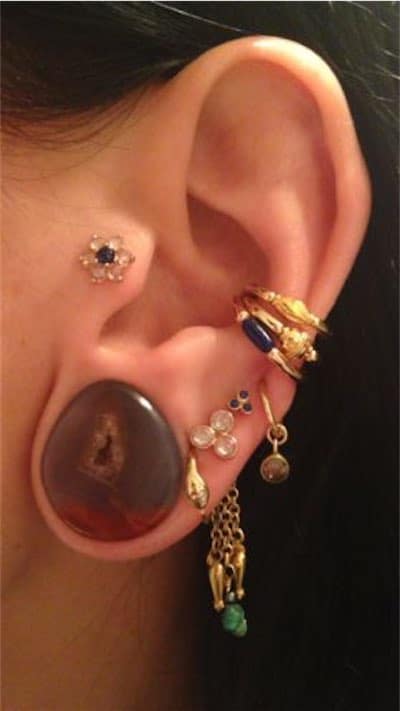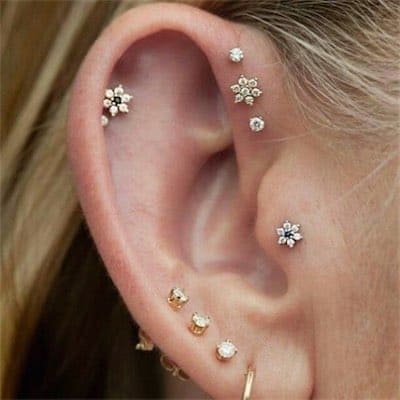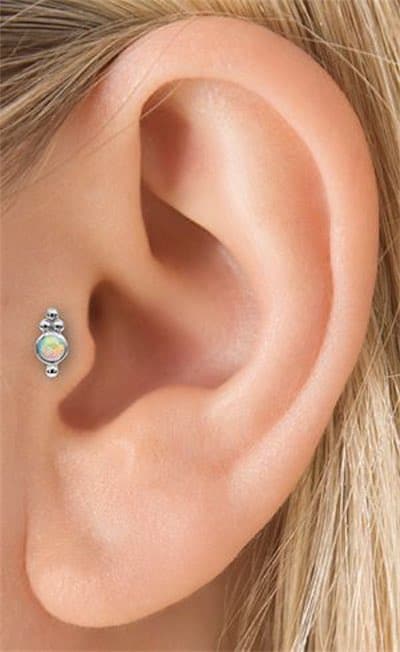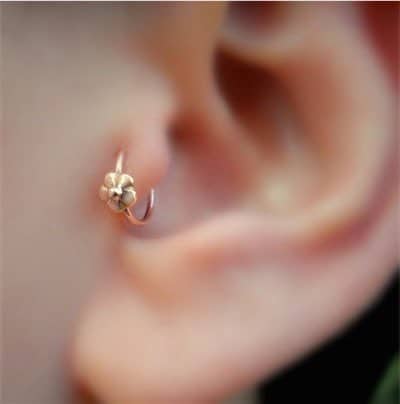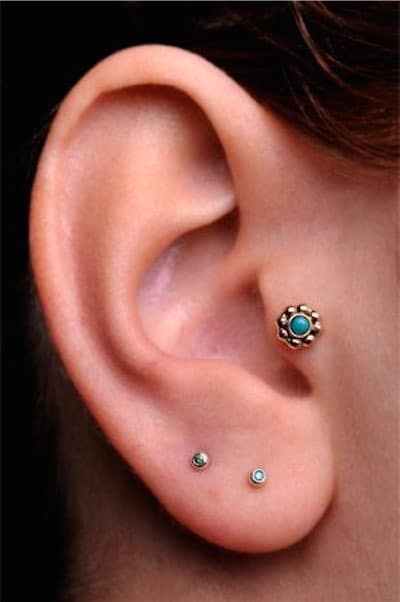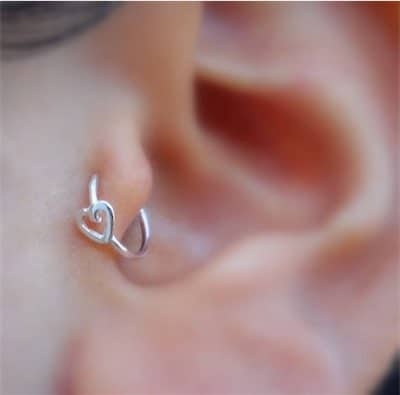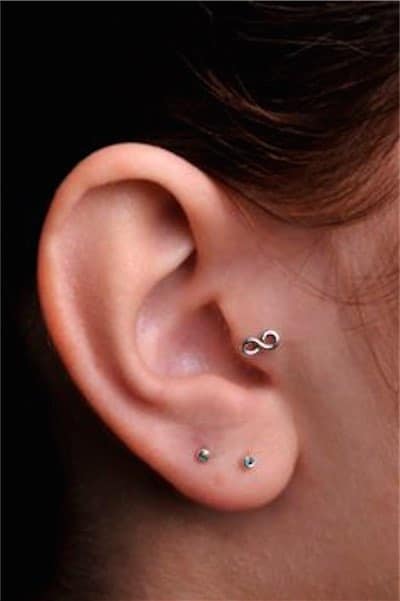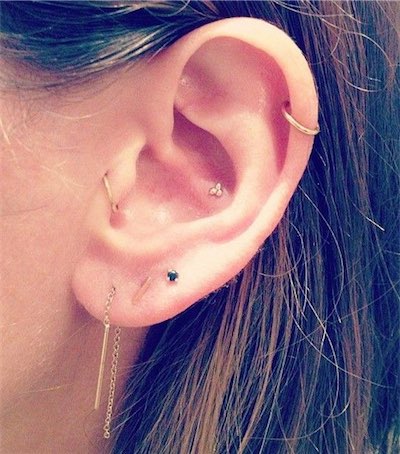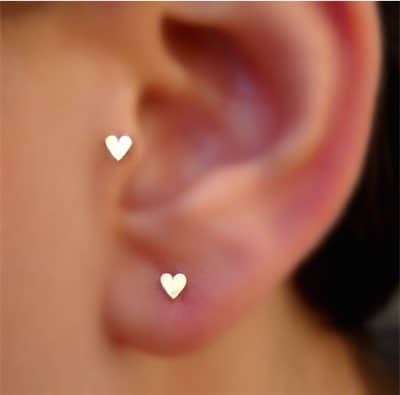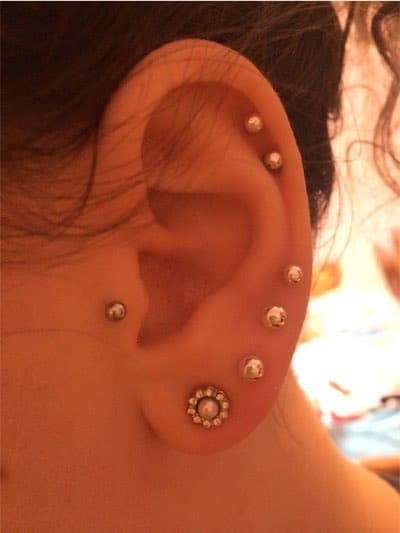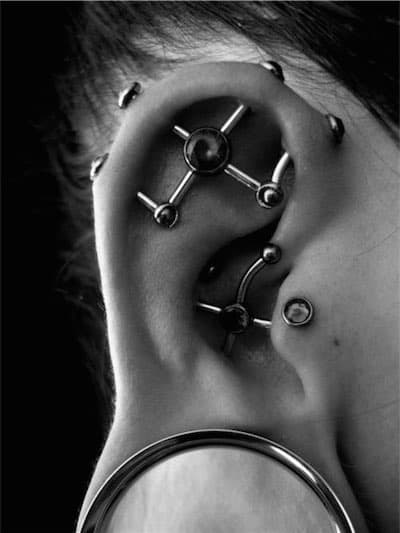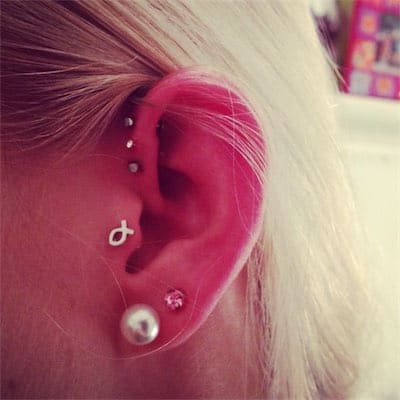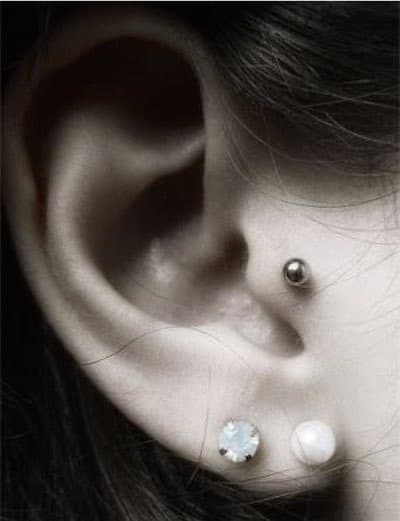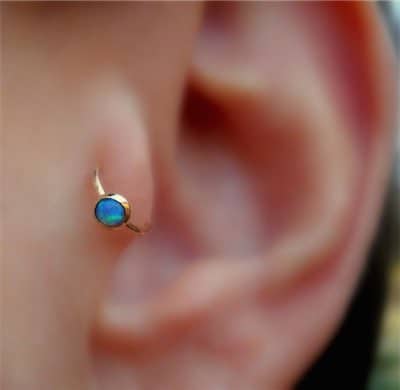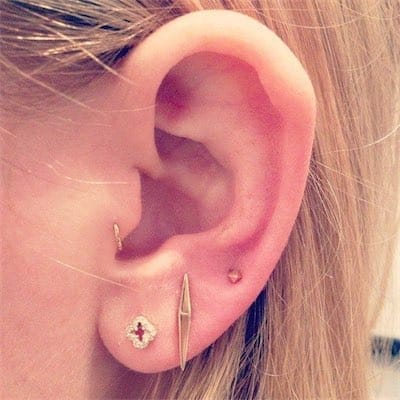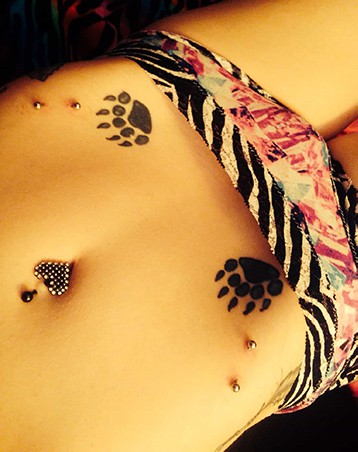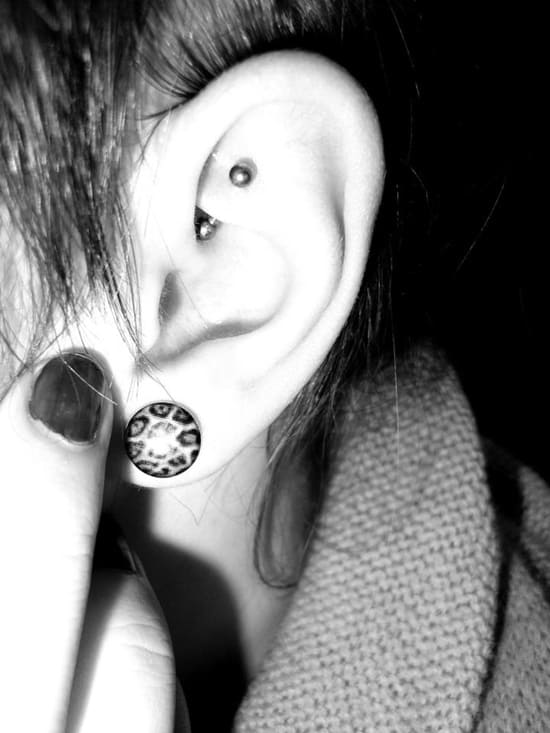Subtle and original, the tragus piercing has recently gained in popularity due to possible benefits to health.
Whether you’re considering a tragus piercing because it looks cool or as a potential remedy, we’ve got you covered!
In this article, you’ll find out everything you need to know about tragus piercings and see some awesome examples in our gallery.
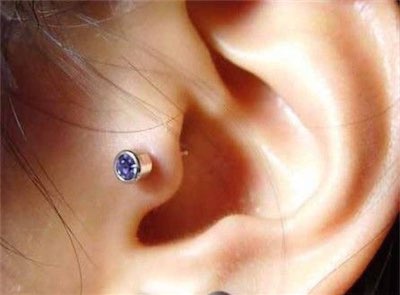
What is a tragus piercing?
Let’s start by identifying the placement of this piercing. Even if the word ‘tragus’ means nothing to you, you’ve surely seen this piercing on others before.
The tragus is located on the ear. The word refers to the small piece of cartilage near the opening of the ear. That’s it!
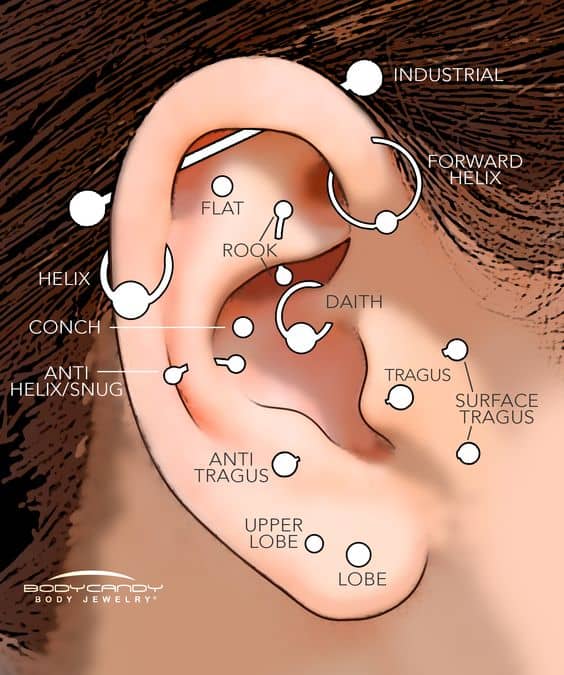
As you can see from the image above, there’s another piercing called the ‘anti-tragus’, on the opposite side form the tragus piercing.
The procedure and aftercare for an anti-tragus is the same as for a tragus piercing, as are the jewelry options.
On a side note, tragus piercings are sometimes mistakenly referred to as ‘trachea piercings’. As a matter of fact, the trachea is… the windpipe, which is definitely not a part of the body that can take a piercing.
Surface piercings
Surface tragus piercings (to the right of the tragus in the image) are different. As the name implies, they are surface piercings.
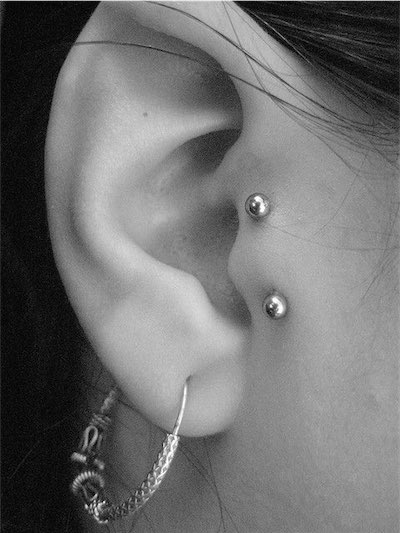
To create a surface piercing, the piercer inserts a staple-shaped barbell under the surface of the skin. Only the ends of the bar are visible, just enough to screw on the beads on either end.
A surface tragus piercing isn’t a cartilage piercing, and isn’t technically an ear piercing at all.
The rest of this article refers to standard tragus piercings, so let’s cover some of the main points of surface piercings here:
- Procedure – the surface piercing procedure is different in that the piercer may use a scalpel rather than a needle (though the needle method is also an option). The scalpel method, surprisingly, is usually less painful than the needle.
- Healing time – surface tragus piercings take an average of 3 months to heal. This varies from person to person, though, and can sometimes take even 9 months to heal completely.
- Cost – surface piercings are more complicated and therefore cost a bit more – usually between $50 – $100.
- Jewelry – because of the nature of this piercing, only surface barbells can be used. Curved barbells or, even worse, straight barbells, are not suitable because they increase the risk of rejection. 14- to 18- gauge staple barbells are most popular, and the length will depend on the anatomy of your ear.
- Risks – surface tragus piercings get rejected more often than standard tragus piercings. Rejection happens when your body chooses to push the jewelry out through the skin rather than heal the tissue around it, often causing scarring.
Microdermal piercings
It’s also possible to get a microdermal piercing in the tragus area, in the same place where the surface tragus is shown on the image above.
Check out our dedicated article on microdermal piercings to find out more.
Tragus piercing procedure
The piercing procedure for the tragus isn’t much different than any other ear piercing.
Disinfection – the piercing professional should start by thoroughly disinfecting the area. This is a crucial step – without it, infection becomes extremely likely.
For your own safety, don’t allow the piercer to proceed without disinfecting your ear first. They should also be wearing gloves.
Marking – with a surgical marker, the piercer will mark the exact spot where the piercing will be. This is for their own reference and for you to check whether you’re happy with the placement.
Piercing – the piercer will use a needle to perforate the tragus. Expect loud noises, as they’re operating so close to your ear canal – and a moment of intense pressure.

Please be aware that using a piercing gun instead of a needle is unacceptable. Tissue damage and infection are much more likely if a piercing gun is used, so you should never allow the piercer to use anything other than a needle.
Jewelry insertion – the piercer will insert your chosen jewelry into the tragus and secure it in place.
And that’s it! The piercer should disinfect the area one more time, then give you aftercare instructions and send you on your way with your brand new tragus piercing.
Can everyone get a tragus piercing?
Everyone’s ears look slightly different. You may have noticed that just as some people have longer lobes and some shorter, not everyone’s tragus is equally prominent.
If your tragus is too small, it may be impossible to pierce it safely. There might not be enough space for the piercer to get in there with the needle, and/or the cartilage may be too small to hold a piercing.
If it turns out that you can’t get a tragus piercing, as your piercer for alternatives. For instance, you may be able to get an anti-tragus, a daith, or a rook.
Also, surface and microdermal piercings (described above) are possible for everyone, regardless of the shape of the ear.
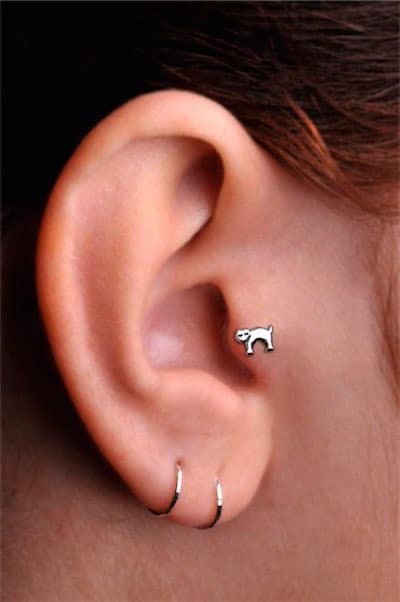
Tragus piercing healing and aftercare
Cartilage piercings take relatively long to heal. The tragus piercing healing time is between 3 – 9 months, although it can sometimes take even up to a year to heal fully.
There are several tragus piercing healing stages during this time. The piercing site will be red, a little swollen, and possibly painful for the first couple of weeks or so.
After that, the discomfort should gradually decrease. The piercing will remain tender to the touch, and there may be some minor discharge.
It can be difficult to know for sure when the piercing has healed fully – and you need to know this if you’re planning on changing your jewelry.
The first time that you change your jewelry from the original piece, it’s best to visit a piercing studio. The piercing professionals there will be able to check whether your piercing has healed and help you with swapping the jewelry safely.
Because the blood-flow and circulation to cartilage is limited, tragus piercings present a higher risk of infection. Make sure you follow the aftercare guidelines for tragus piercings to minimize the risk of any complications.
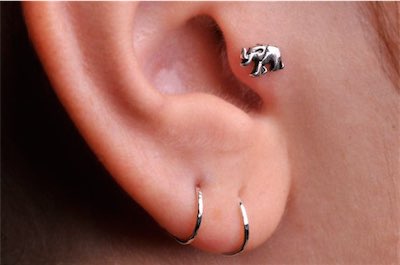
Tragus piercing cost
A tragus piercing will cost you around $30 – $50 for the procedure, plus the cost of the jewelry.
As with every other piercing, the main factor determining the cost is the expertise of the piercer. Naturally, it’s important not to try to save money on something as important (and difficult) as body modification.
Choose a professional with experience in tragus piercings, a high standard of hygiene, and a well-equipped studio. Firstly, this will help to make sure that you’re happy with the finished piercing. Secondly, it will minimize the risks involved in getting a piercing, such as infection.
Keep in mind, though, that price isn’t always a reflection of quality. Take advantage of reviews and recommendations from others before you make an appointment.
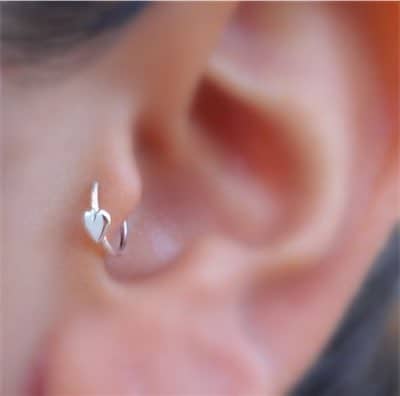
Tragus piercing pain
It won’t surprise you to hear that the pain level of a tragus piercing will depend on your individual tolerance.
Some people can handle pain better than others, and some find that specific areas of their body are particularly sensitive to pain.
It’s therefore difficult to give a universal answer as to how much it hurts to get a tragus piercing.
Most people who underwent the procedure consider it manageable, often more uncomfortable than painful.
When piercing the tragus, the piercer has to push the needle through tough cartilage. The pressure is mostly responsible for making the experience uncomfortable.
Regardless of your pain tolerance, keep in mind that the act of piercing itself will only take a couple of seconds. There are few nerve endings in the tragus, so the pain won’t be intense for long.
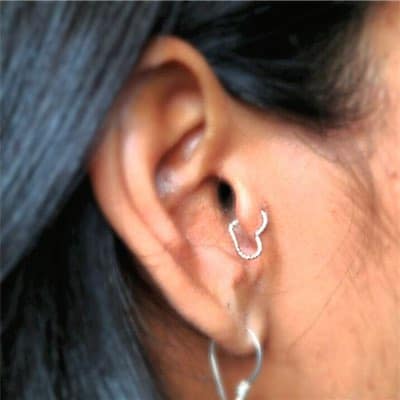
Potential health benefits
You may have heard about the tragus piercing health benefits. Specifically, there is some evidence that they can help to alleviate migraines.
The idea behind this theory comes from acupuncture. Acupuncture is a treatment which involves placing needles in specific pressure points on the body to stimulate nerves and help with different health problems.
One of the nerves that may be stimulated to help with migraine pain is the vagus nerve, which passes through the tragus. Research proves that acupuncture of the vagus nerve can help with depression and epilepsy – scientists are still working to find out whether it can treat migraine pain.
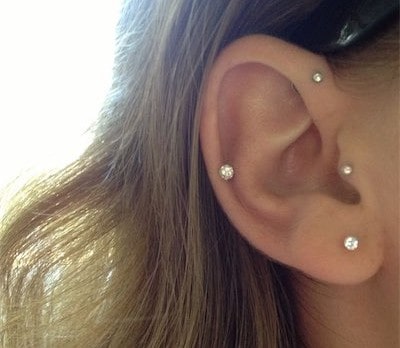
So, in a way, getting your tragus pierced is a way to permanently stimulate the vagus nerve, hopefully helping with your migraines. The Daith piercing is another procedure that stimulates the same nerve, and is also believed to benefit migraine sufferers.
Please bear in mind that the evidence for this is anecdotal, which is to say that no scientific studies have confirmed it. Many people say it helps, but scientists haven’t said it definitely does.
At the end of the day, if you’re willing to undergo the procedure and look after the piercing, there’s no harm in trying. There is no definitive remedy for migraines, so many people think it’s worth trying every method available.
Tragus piercing jewelry
Depending on the shape of your ear and the size of your tragus, a piercing professional will be able to advise you on the starting jewelry.
In general, there are two main categories of jewelry: a stud and a tragus hoop.
Some people also use small barbells. They’re a viable option, though they might be uncomfortable if they stick out too much on the inner side.
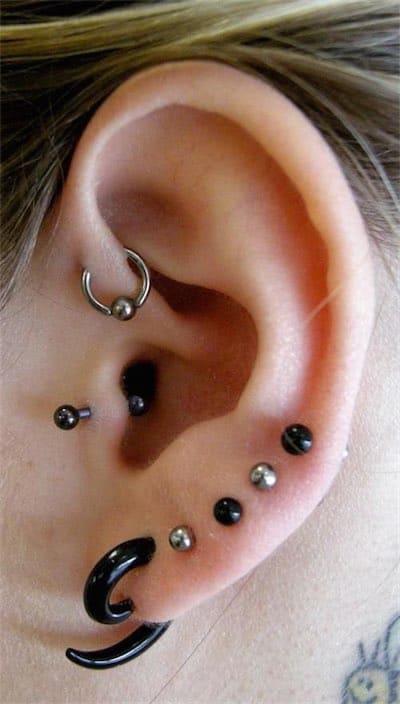
Tragus piercing stud
Studs are the most popular option, partly because they might be more comfortable depending on the shape of your ear.
In terms of structure there are two types of studs: with a flat backing and with a round bead on the back end.
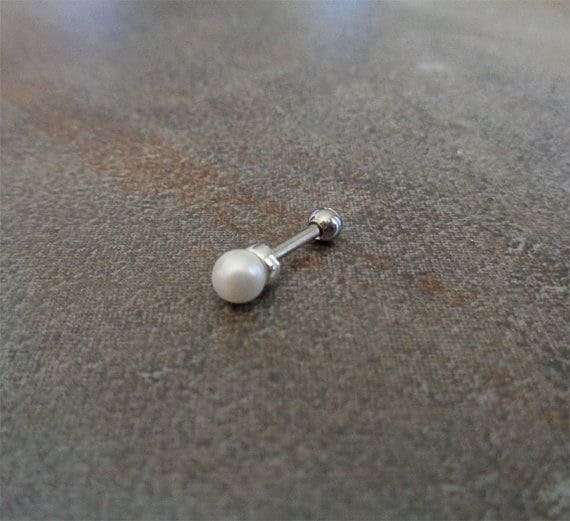
If there’s not a lot of space on the inner side of your tragus piercing, a flat backing will be the better option.
You won’t feel it as much, especially when wearing headphones.
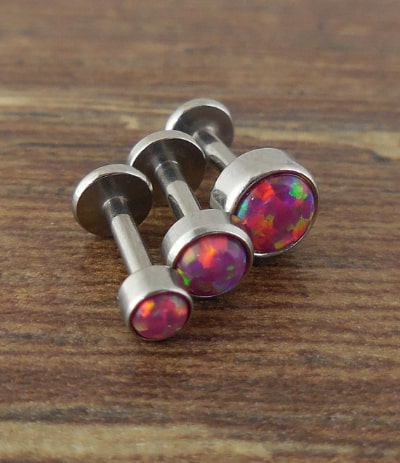
Of course, studs come in many shapes and varieties – from simple metals or gems to intricate shapes.
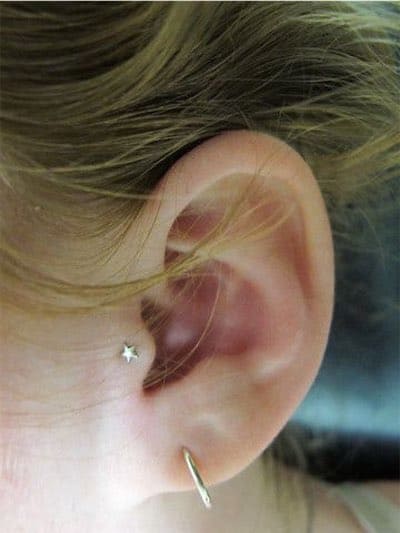

Tragus piercing hoop
There are three types of hoops for tragus piercings:
- Captive bead rings – these have a bead which holds the ends of the ring in place. The bead and the ring can be decorative or plain.
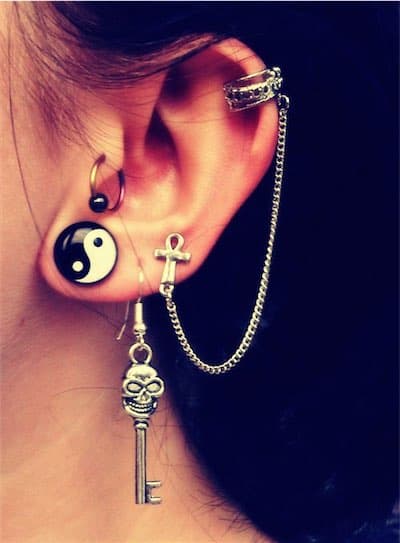
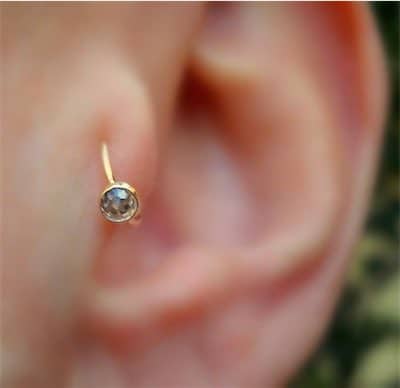
- Seamless hoops – these don’t have the bead to connect the ends. They’re simpler than captive bead rings and have a sleeker look.
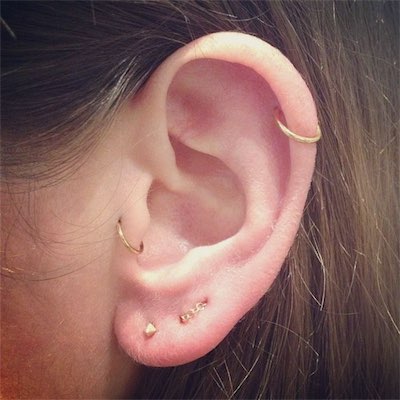
- Hinged rings – these lock using a hinged mechanism, securing the ring into place. They’re usually a bit more expensive than the other types of tragus hoops.
Final words
That’s all! We hope you’ve found the answers to all your questions about tragus piercings here. Now, enjoy browsing our gallery of tragus piercing jewelry – good luck finding the best pieces to suit your style!
